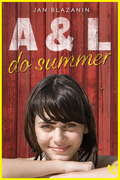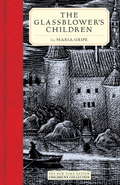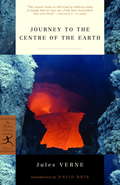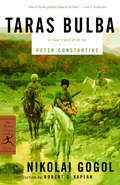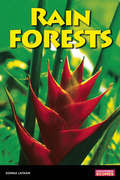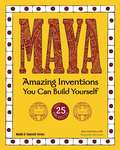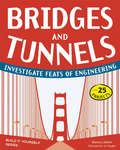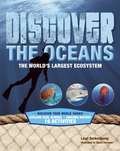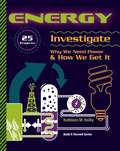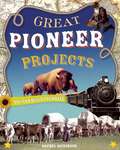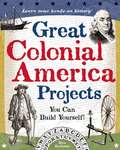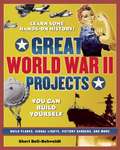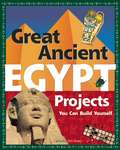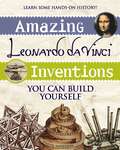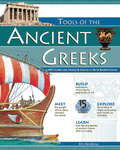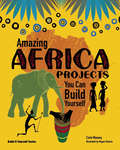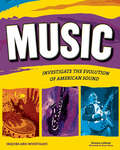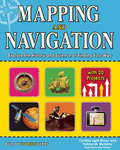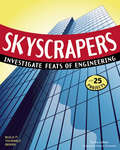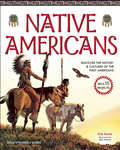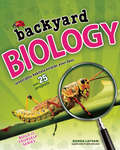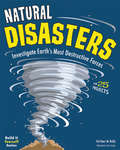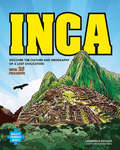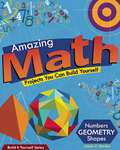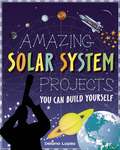- Table View
- List View
A&L Do Summer
by Jan BlazaninIn Iowa farm country, sixteen-year-old Aspen and her friend Laurel plan to get noticed the summer before their senior year and are unwittingly aided by pig triplets, a skunk, a chicken, bullies, a rookie policeman, and potential boyfriends.
The Glassblower's Children
by Maria Gripe Harald GripeBy the Winner of the Hans Christian Andersen Medal for Lifetime Achievement in Children's LiteratureAlbert the Glassblower and Sofia are the loving parents of little Klas and Klara. Albert makes the most beautiful glass bowls and vases (unfortunately they are so impractical that no one will buy them), while Sofia supports the family by working in the fields. Every year Albert goes to the fair to try to sell his wares, and sometimes Sofia and the children go too. At the fair the family meets Flutter Mildweather, a weaver of magical rugs that foretell the future, and Klas and Klara come the attention of the splendid Lord and Lady of All Wishes Town, who have everything they want except for one thing: children.Full of curious and vivid characters--like the one-eyed raven Wise Wit, who can only see the bright side of life, and the monstrous governess Nana, whose piercing song can shatter glass--The Glassblower's Children also ponders such serious matters as what it means to find meaningful work and the difference between what you want and what you need. In The Glassblower's Children Maria Gripe has drawn on fairy tales and Norse myths to tell a thrilling story with a very modern sensibility.
Journey to the Centre of the Earth
by Jules Verne David BrinThe intrepid Professor Lindenbrock embarks upon the strangest expedition of the nineteenth century: a journey down an extinct Icelandic volcano to the Earth's very core. In his quest to penetrate the planet's primordial secrets, the geologist--together with his quaking nephew Axel and their devoted guide, Hans--discovers an astonishing subterranean menagerie of prehistoric proportions. Verne's imaginative tale is at once the ultimate science fiction adventure and a reflection on the perfectibility of human understanding and the psychology of the questor. As David Brin notes in his Introduction, though Verne never knew the term "science fiction," Journey to the Centre of the Earth is "inarguably one of the wellsprings from which it all began."From the Trade Paperback edition.
Taras Bulba
by Robert D. Kaplan Nikolai Gogol Peter ConstantineThe First New Translation in Forty YearsSet sometime between the mid-sixteenth and early-seventeenth century, Gogol's epic tale recounts both a bloody Cossack revolt against the Poles (led by the bold Taras Bulba of Ukrainian folk mythology) and the trials of Taras Bulba's two sons.As Robert Kaplan writes in his Introduction, "[Taras Bulba] has a Kiplingesque gusto . . . that makes it a pleasure to read, but central to its theme is an unredemptive, darkly evil violence that is far beyond anything that Kipling ever touched on. We need more works like Taras Bulba to better understand the emotional wellsprings of the threat we face today in places like the Middle East and Central Asia." And the critic John Cournos has noted, "A clue to all Russian realism may be found in a Russian critic's observation about Gogol: 'Seldom has nature created a man so romantic in bent, yet so masterly in portraying all that is unromantic in life.' But this statement does not cover the whole ground, for it is easy to see in almost all of Gogol's work his 'free Cossack soul' trying to break through the shell of sordid today like some ancient demon, essentially Dionysian. So that his works, true though they are to our life, are at once a reproach, a protest, and a challenge, ever calling for joy, ancient joy, that is no more with us. And they have all the joy and sadness of the Ukrainian songs he loved so much."From the Hardcover edition.
Rain Forests
by Donna LathamInvestigating a variety of biomes and today's natural and human threats to their preservation, this interactive series challenges young readers to look at how their own actions influence the planet's health. Four distinct environments are explored in detail, showcasing the assortment of plants and animals that inhabit these outdoor communities as well as how they have adapted to their surroundings. Offering fascinating facts on each ecosystem along with vocabulary-building sidebars, these guides show budding scientists how they can contribute towards ongoing conservation efforts. Showcasing one of the environment's most valuable biomes, this overview centers on the planet's rain forests, reviewing the greenhouse gases and the accelerating extinction of species that jeopardize this vital ecosystem's future.
MAYA
by Sheri Bell-Rehwoldt Tom CasteelRevised in 2012 Maya: Amazing Inventions You Can Build Yourself introduces readers ages 9-12 to the world of the ancient Maya, the most advanced and mysterious civilization of the New World. From ceremonial masks to hieroglyphics, and calendars to musical instruments, Maya: Amazing Inventions You Can Build Yourself gives readers a chance to experience how the Maya lived, cooked, worshipped, entertained themselves, and interacted with their neighbors through hands on building projects that use common household supplies. Detailed step-by-step instructions for each project are combined with historical facts and anecdotes, biographies, and trivia. Together they give kids a first-hand look at daily life in ancient Mesoamerica..
Bridges and Tunnels
by Donna Latham Jenn VaughnBridges and tunnels are lifelines. People have tackled seemingly insurmountable obstacles, including vast canyons and mountain ranges, to design and construct these amazing passageways. Bridges and Tunnels: Investigate Feats of Engineering invites children ages 9 and up to explore the innovation and physical science behind structures our world depends on. Trivia and fun facts illustrate engineering ingenuity and achievements. Activities and projects encourage children to learn about the engineering process and to embrace trial and error.
Discover the Oceans
by Lauri Berkenkamp Chuck ForsmanFrom both a historical and scientific point of view, above and below the surface, this engaging guide brings the world's oceans to life through fun facts, illustrations, and in-depth information. Interactive activities appear throughout, ranging from making solar stills and simple fishing spears to experimenting with a homemade diving bell and figuring out how much water it really takes to survive. With the oceans being the least explored environment on Earth, this reference illuminates some of the most incredible and surprising plants and animals as well as how to survive and navigate these vast expanses.
ENERGY
by Kathleen M ReillyEnergy is a vital part of our lives. It powers our computer, lights our home, and moves our car. It also costs a lot of money and pollutes our environment. In Energy: 25 Projects Investigate Why We Need Power and How We Get It, kids ages 9-12 learn about the history and science of the world's energy sources, from nonrenewable fossil fuels such as oil and natural gas to renewable sources such as solar and wind power.Sidebars and fun trivia break up the text, making it easily accessible and engaging, while hands-on projects encourage active learning. Requiring little adult supervision and using supplies commonly found in most households, activities range from constructing a battery to recreating an oil spill to see howdifficult cleanup can be.By exploring the advantages and disadvantages of each energy source, kids will gain insight into the future of energy and its impact on our planet.
GREAT PIONEER PROJECTS
by Shawn Braley Rachel DickinsonWhat was it like to be an American pioneer during the 1800s? Great Pioneer Projects You Can Build Yourself introduces readers ages 9 and up to the settling of the great American frontier with over 25 hands-on building projects and activities. Young learners build replica sod houses, log cabins, and covered wagons and create their own printing presses and maps. Great Pioneer Projects You Can Build Yourself provides detailed step-by-step instructions, diagrams, and templates for creating each project. Historical facts and anecdotes, biographies, and fascinating trivia support the fun projects and teach readers about the American pioneers' relentless push westward. Together they give kids a first-hand look at daily life on the trail and on the frontier. Great Pioneer Projects You Can Build Yourself brings the American Pioneer experience to life.
Great Colonial America Projects
by Kris BordessaGreat Colonial America Projects You Can Build Yourself introduces readers ages 9-12 to colonial America through hands-on building projects. From dyeing and spinning yarn to weaving cloth, from creating tin plates and lanterns to learning wattle and daub construction. Great Colonial America Projects You Can Build Yourself gives readers a chance to experience how colonial Americans lived, cooked, entertained themselves, and interacted with their neighbors.
GREAT WORLD WAR II PROJECTS
by Sheri Bell-RehwoldtFrom spy maps and victory banners to spotter planes and ration cakes, Great World War II Projects You Can Build Yourself brings one of the most defining periods of American and world history to life through hands-on building projects and activities. Detailed step-by-step instructions for creating each project combine with historical facts and anecdotes, biographies, and trivia about the real-life models. Together they give kids a first-hand look at daily life at home and on the front lines during America's war years.
Great Ancient EGYPT Projects
by Carmella Van VleetFrom reed boats, papyrus, and amulets, to pyramids, pharaohs, and mummies, Great Ancient Egypt Projects You Can Build Yourself explores the fascinating lives of ancient Egyptians through more than25 hands-on building projects and activities. Great Ancient Egypt Projects You Can Build Yourself gives readers today a chance to experience how the ancient Egyptians lived, cooked, worked, worshipped, entertained themselves, and interacted with their neighbors through building projects that use common household supplies.Detailed step-by-step instructions, diagrams, and templates for creating each project are combined with historical facts and anecdotes, biographies, and trivia for the real-life models of each project. Together they give kids a first-hand look at daily life in ancient Egypt.
Amazing Leonardo da Vinci Inventions
by Maxine AndersonAmazing Leonardo da Vinci Inventions You Can Build Yourself introduces readers to the life, world, and incredible mind of Leonardo da Vinci through hands-on building projects that explore his invention ideas. Most of Leonardo's inventions were never made in his lifetime-they remained sketches in his famous notebooks. Amazing Leonardo da Vinci Inventions You Can Build Yourself shows you how to bring these ideas to life using common household supplies. Detailed step-by-step instructions, diagrams, and templates for creating each project combine with historical facts and anecdotes, biographies and trivia about the real-life models for each project. Together they give kids a first-hand look intothe amazing mind of one the world's greatest inventors.
TOOLS OF THE ANCIENT GREEKS
by Kris BordessaTools of the Ancient Greeks: A Kid's Guide to the History and Science of Life in Ancient Greece explores the scientific discoveries, athletic innovations, engineering marvels, and innovative ideas created more than two thousand years ago. Through biographical sidebars, interesting facts, fascinating anecdotes, and fifteen hands-on activities, readers will learn how Greek innovations and ideas have shaped world history and our own world view.
Amazing AFRICA PROJECTS
by Carla Mooney Megan SternsWhile Africa is one continent it contains many diverse countries. Amazing Africa Projects You Can BuildYourself introduces readers ages 9 and up to the stunning landscapes, ancient civilizations and ethnic groups, unique traditions, and amazing wildlife of the vast African continent.With 25 fun projects that kids can complete using common household supplies and many recycled materials, kids learn about life in Africa. Step-by-step instructions show young readers how to make their own shields for an initiation ceremony, cook banana fritters and fufu cakes, and design animal masks to commemorate the seasons. Kids will celebrate Africa and its place in our world.
Music
by Donna Latham Bryan StoneThe United States boasts a rich musical diversity. Colonial Americans integrated European traditions with new cultural influences to compose a unique musical identity. African traditions influenced hymns and folk songs that connected people to religion and to the trials and tribulations of everyday life. Patriotic tunes created unity in wartime. America's jazz, blues, rock, and hip-hop continue to evolve from their African-American origins. Music: Investigate the Evolution of American Sound invites kids ages 12 and up to explore the roots of American music genres as they investigate the social, political, and religious influences that inspire musicians. Activities encourage readers to inquire into the art and science of music. Readers can engage in a hands-on exploration of the physics of sound vibrations, decibel levels, and acoustics, or use vocal styling to improvise and discover the rhythm of their bodies to create a beatbox. Music encourages readers to analyze lyrics, their meanings, and rhythms, and then use that analysis to write their own songs. This title meets common core state standards in language arts for reading informational text and literary nonfiction and is aligned with Next Generation Science Standards. Guided Reading Levels and Lexile measurements indicate grade level and text complexity.
Mapping and Navigation
by Cynthia Light Brown Beth Hetland Patrick McgintyHow did we get from 20-foot-long maps to GPS devices small enough to fit in the palm of our hands? How does GPS work and what can it tell us? How do ancient mapmaking techniques used by the Romans and Greeks influence the satellite technologies we use today? The history of mapmaking is full of remarkable characters who charted the unknown with an ever-changing set of tools. In Mapping and Navigation: The History and Science of Finding Your Way, kids ages 9-12 will learn the history and science behind the evolution of mapmaking, and how much is still out there for discovery.Readers will explore ideas through hands-on experiments while learning new terminology and interesting facts. Projects include using triangulation to measure distances, creating contour lines on a mini-mountain to understand elevation changes on a map, and inventing a sundial and compass to understand the basics of navigation. Whether mapping the solar system or mapping their own backyard, all readers will be able to understand mapping technologies and see the world in new and exciting ways.
SKYSCRAPERS
by Andrew Christensen Donna LathamOver centuries and across cultures people have defied gravity in a quest to build the tallest, grandest structures imaginable.Skyscrapers: Investigate Feats of Engineering with 25 Projects invites children ages 9 and up to explore the innovation and physical science behind these towering structures. Trivia and fun facts illustrate engineering ingenuity and achievements from the ancient pyramids to the Empire State Building. Readers will develop an understanding of how our modern, sophisticated building techniques and materials evolved over time.Activities and projects encourage children to explore the engineering design process. They will engage in hands-on explorations of wind, test Newton's laws of motion, and experiment with the strength of different shapes. In the process they will learn about gravity, inertia, oscillation, and static electricity. Using various materials and engaging in trial and error, readers will construct their own towers and skyscrapers. Skyscrapers meets common core state standards in language arts for reading informational text and literary nonfiction and is aligned with Next Generation Science Standards. Guided Reading Levels and Lexile measurements indicate grade level and text complexity.
Native Americans
by Kim Kavin Beth HetlandExplore how the first Americans, faced with varying climates in a vast land hundreds and thousands of years ago, developed everything we take for granted today: food supplies, shelter, clothing, religion, games, jewelry, transportation, communication, and more.Native Americans: Discover the History and Cultures of the First Americans uses hands-on activities to illuminate how the Native Americans survived and thrived by creating tools, culture, and a society based on their immediate environment. Entertaining illustrations and fascinating sidebars bring the topic to life, while Words to Know highlighted and defined within the text reinforce new vocabulary. Projects include building an archaic toolkit, creating Algonquin art, experimenting with irrigation systems, inventing hieroglyphics, making a "quinzy," and playing the Inuit game of nugluktaq. In addition to a glossary and an index, an extensive appendix of sites and museums all over the country offers ideas where families can learn more about the various Native American cultures.Kids ages 9-12 will gain an appreciation for the diversity of people and culture native to America, and learn to problem solve in a way that respects the environment.
Backyard BIOLOGY
by Donna Latham Beth HetlandBIOLOGY IS THE STUDY OF LIFELife is everywhere, thriving in the city and in the country, teeming in ecosystems around the planet-in deserts, oceans, and even the Arctic. And life is right outside your door! Backyard Biology invites children ages 9 and up to investigate living things-especially in yards, parks, nature areas, and playgrounds. Trivia and fun facts bring animals, plants, and microorganisms to life, in all their wonder.Readers become Nature Detectives with activities and projects that encourage children to make discoveries. Children will construct a plankton net to collect pond samples, and they'll grow microorganisms in a Winogradsky Column. They'll discover what mystery plants sprout from collected soil samples and build a rolypoly habitat. When children experiment with phototropism and geotropism, they'll discover the ways plants move. In Backyard Biology, children will scout out different habitats to observe and investigate-and do their part to protect them.
Natural Disasters
by Kathleen M Reilly Tom CasteelWhen natural disasters happen they grab headlines around the world. People, creatures, and the environment are all impacted when nature gets out of control. Natural disasters can be upsetting to live through, but scientists today better understand their causes and how we can protect ourselves and others. Natural Disasters: Investigate Earth's Most Destructive Forces with 25 Projects teaches readers about some of the natural disasters throughout history, what caused them, their impact on civilizations, and how people today cope with natural disasters. Readers of this book will make their own shake tables, create a cake batter lava flow, invent a wind tunnel, and experiment with avalanches. These hands-on activities engage readers and add depth to the text while ensuring that the learning is made lasting and fun.
Inca
by Farah Rizvi Lawrence KovacsRevealing legends and legacies, Inca: Discover the Culture and Geography of a Lost Civilization with 25 Projects offers engaging insight into the continent-sprawling ancient Inca culture. The text and activities invite learners on a journey along the Inca Trail. They'll visit the city of Cuzco and the majestic Machu Picchu, built on a jagged ridge thousands of feet above the Urubamba River. Kids will learn about cultural beliefs, rituals, scientific advances, and languages. They'll create Salar de Uyuni salt crystals and build a tropical cloud forest. This captivating educational tool also features unique illustrations, informative sidebars, fun-fact questions, and vocabulary that will interest readers from start to finish.
Amazing Math Projects
by Samuel Carbaugh Lazlo C. BardosMake a geodesic dome big enough to sit in. Solve one of the world's hardest two-piece puzzles. Pass a straight line through a curved slot.From prime numbers to paraboloids, Amazing Math Projects You Can Build Yourself introduces readers ages 9 and up to the beauty and wonder of math through hands-on activities. Kids will cut apart shapes to discover area formulas, build beautiful geometric models to explore their properties, and amaze friends with the mysterious Möbius strip.Learning through examples of how we encounter math in our daily lives, children will marvel at the mathematical patterns in snowflakes and discover the graceful curves in the Golden Gate Bridge. Readers will never look at soap bubbles the same way again!Amazing Math Projects You Can Build Yourself includes projects about number patterns, lines, curves, and shapes. Each activity includes intriguing facts, vocabulary builders, and connections to other topics. A companion website, includes video instructions for many projects in the book and provides additional activities.
AMAZING SOLAR SYSTEM PROJECTS
by Shawn Braley Delano LopezAmazing Solar System Projects You Can Build Yourself introduces readers ages 9 and up to the basic elements of the solar system with over 25 hands-on building projects and activities. Readers learn about the sun, the planets and their moons, meteors and comets, and the amazing tools that astronomers and astronauts have used to study the solar system over the years.Amazing Solar System Projects You Can Build Yourself provides detailed step-by-step instructions and diagrams for creating the projects, which include making a greenhouse to see what happens on Venus and constructing a model of the phases of the moon to demonstrate why the moon has phases. Fascinating facts, anecdotes, biographies, and trivia are interspersed with the fun projects to teach readers all about the solar system.
